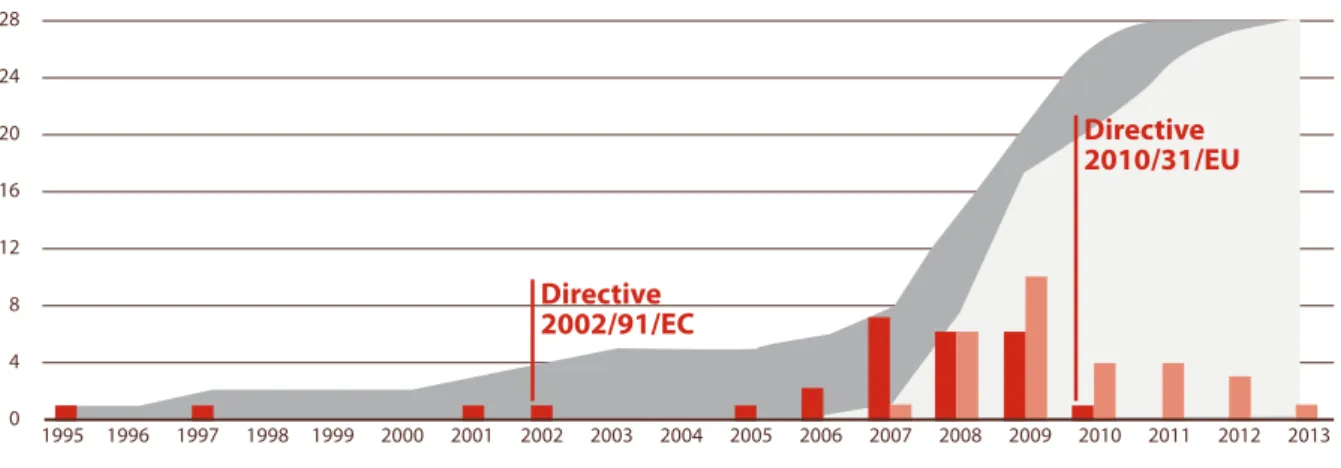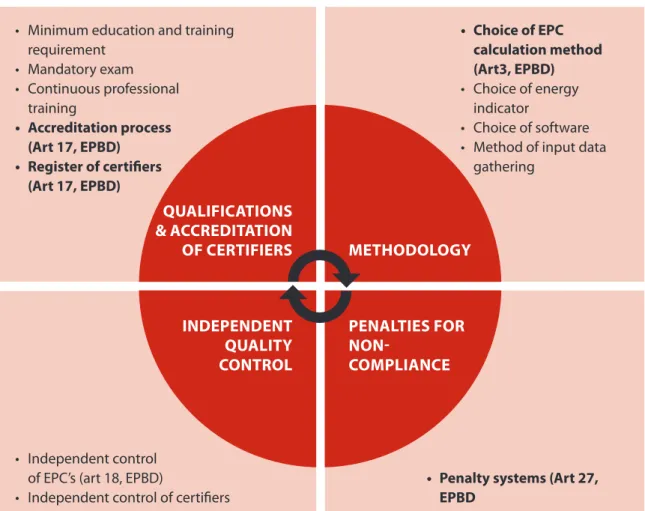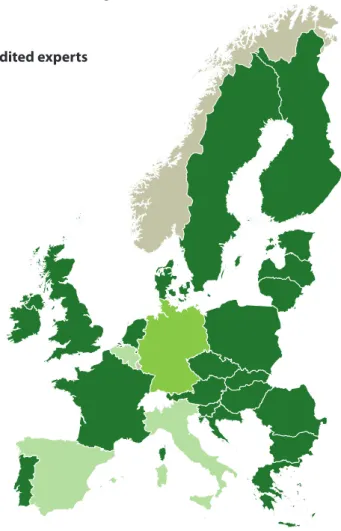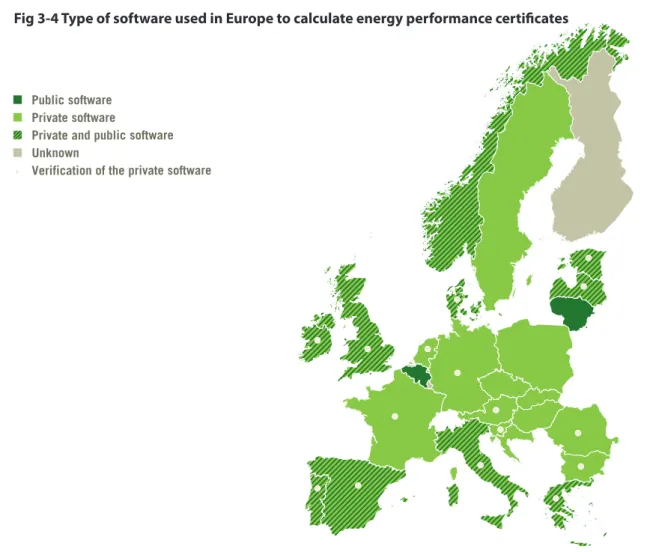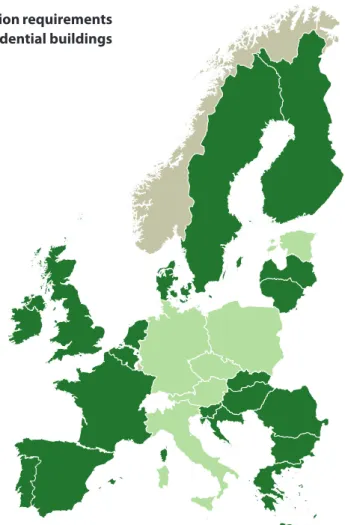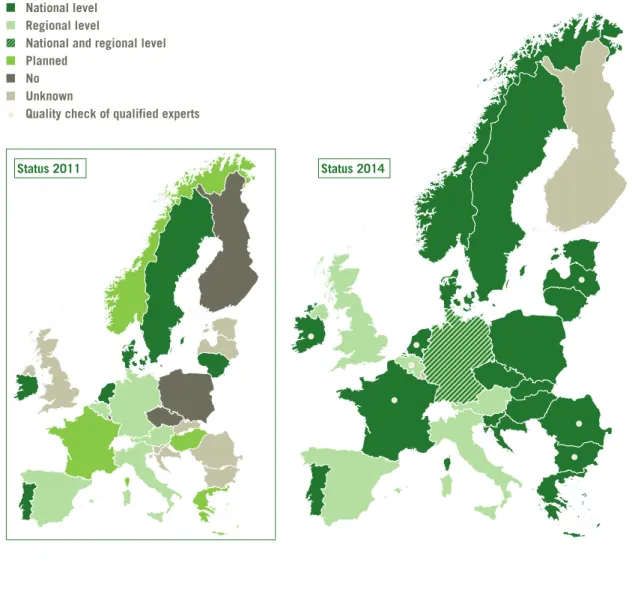1 Directive 2002/91/EC of the European Parliament and of the Council of 16 December 2002 on the energy performance of buildings. 9 Directive 2010/31/EU of the European Parliament and of the Council of 19 May 2010 on the energy performance of buildings (recast).

LEGISLATIVE FRAMEWORK FOR IMPLEMENTATION OF THE ENERGY PERFORMANCE CERTIFICATE SCHEME
CONCLUSIONS AND RECOMMENDATIONS
2 ENERGY PERFORMANCE
CERTIFICATES: FROM DESIGN TO IMPLEMENTATION
Energy Performance Certificates and the first EPBD (2002/91/EC) 12
To date, all 28 Member States have formally introduced the EPBD requirements for EPCs into their national legislation; only minor changes are expected: for Hungary, where voluntary EPCs for rented buildings will be replaced by mandatory EPCs in 2015, and for Slovakia, where mandatory certification of building units will come into force in 2016. In the Belgian Flemish region, energy efficiency certification for non-residential and non-public buildings is scheduled for 2015, while the Wallonia region will start certifying existing non-residential buildings in the same year.
Requirements of the EPBD recast (2010/31/EU)
Quality assurance
The EPBD recast expands the requirements regarding the independent qualified and/or accredited experts who are entitled to carry out the assessment of a building's energy performance. The new requirements introduced in the EPBD recast are important elements of the quality assurance of the EPCs (see Figure 2-2).
Availability
The revision of the Directive strengthens the rules for the display of EPCs in buildings occupied by public authorities and frequently visited by the public. To improve the functioning of the EPC system, the reformulation of the EPBD introduced mandatory penalties for non-compliance23 (Article 27).
Usability of EPC information
The aim of the project was to make use of EPC data to improve knowledge about the energy performance of the building stock in Europe. Additionally, investing in energy-efficient renovations is a key topic of the Energy Efficiency Financial Institutions Group (EEFIG), which identifies the importance of EPCs in making financial decisions, including borrowing (EEFIG 2014).
3 QUALITY ASSURANCE OF THE EPC
Requirements for qualified and/or accredited experts 25
Minimum requirements for education and/or professional experience
Training programmes
Mandatory exam
Continuous Professional Development
Accreditation procedure
There is no official accreditation procedure in Germany; Nevertheless, qualified experts can obtain accreditation on a voluntary basis through professional associations and external bodies. In this case, the qualified experts are accredited by the regional government authorities (for Belgium) and professional associations.
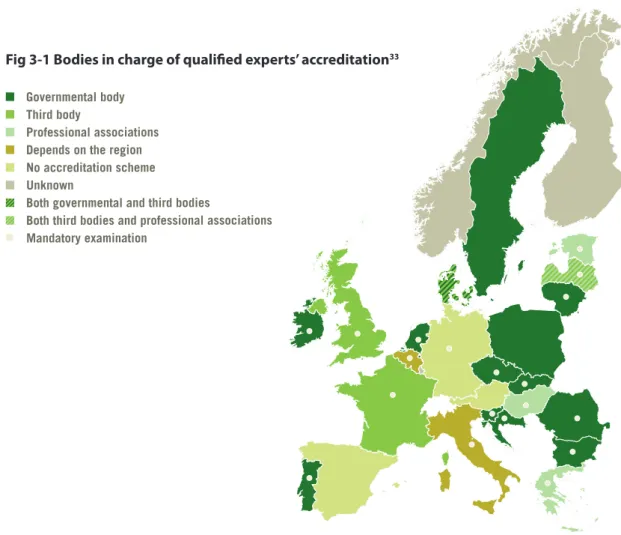
EPC methodology and tools
The list of certifiers
The choice of methodology and energy performance indicator (ie energy label; federal scale) to be presented on the energy card is largely determined by the credibility, (acceptable) repeatability37 and cost of the EPC [BPIE, 2010]. In most countries, the energy efficiency label is introduced in the form of an energy label, while in others (Belgium-Flanders, Germany, Latvia, Luxembourg, Poland and Slovenia) a federal scale is used.
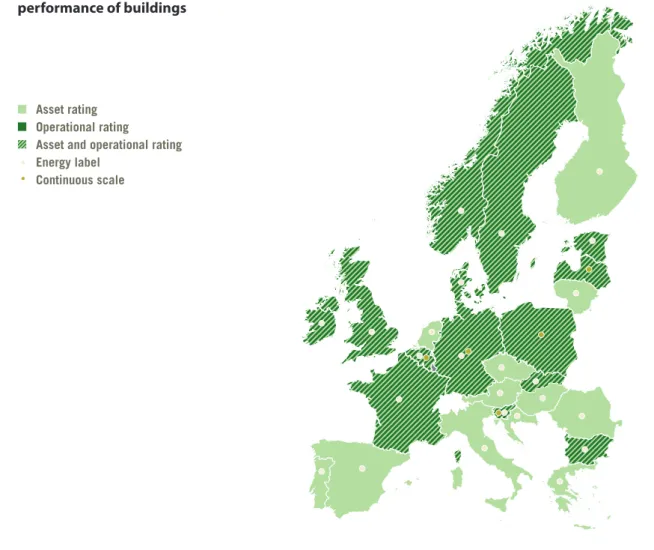
Software
For example, in Germany and Slovenia, a continuous scale is usually used, but for residential buildings energy labels are additionally offered since 2014. In Luxembourg a continuous scale is used for non-residential buildings, while an energy label is used for residential buildings.
Input data
In Italy, the calculation of EPCs at the regional level is possible using commercial software that is certified in accordance with the national algorithm and technical standards.
Independent control systems for energy performance certificates
The quality control system is usually performed in two stages: a simple audit of the input data and results (according to option A of Annex II, EPBD) and a detailed audit that takes into account extensive verification of the inputs, results and recommendations. including a review of the project documentation and a site visit (according to options B and C of Annex II of the EPBD). The deadline for the implementation of the independent quality control systems was set in the EPBD on January 9, 2013.
Random sampling
Bodies in charge of EPC quality control
In Hungary and Latvia47, the competence for quality control of EPCs is in the hands of the organization that carries out the accreditation of qualified experts; which is, in both cases, the professional association of engineers and architects. In the United Kingdom48, France and Sweden, these are the bodies responsible for the accreditation of qualified experts.
Penalties for qualified experts
In Denmark, in parallel with the quality control system carried out by the government body, accredited companies follow an internal quality assurance system based on DS/EN ISO 9001. In Italy, for example, some regional bodies refer directly to the national approach; others have defined their own rules (in principle more restrictive than the national ones) [CTI 2013].
Administrative penalties
Two penalty points SEVERITY 3 A minor offense which would not affect the reputation of.
Monetary penalties
4 AVAILABILITY AND USABILITY OF EPC DATA
EPC REGISTERS ACROSS EUROPE
Status of implementation
Scope of the EPC register
IRELAND All data in calculation software; all data provided in the EPC, certifier's background. In some countries (eg Lithuania, Greece, Hungary, France, Ireland and the UK), in addition to the data provided in the EPC, additional information is required in the database.
Upload of EPC data
In some countries, there are multiple ways to upload EPC data; for example in Hungary, experts can either upload the standardized data protocol directly to the database or manually enter the data into the online platform (in case the software used does not provide the results in the standardized format). In Slovenia, all EPCs are stored electronically in the beta version of the register, but in parallel the Ministry also collects a hard copy of the EPC.
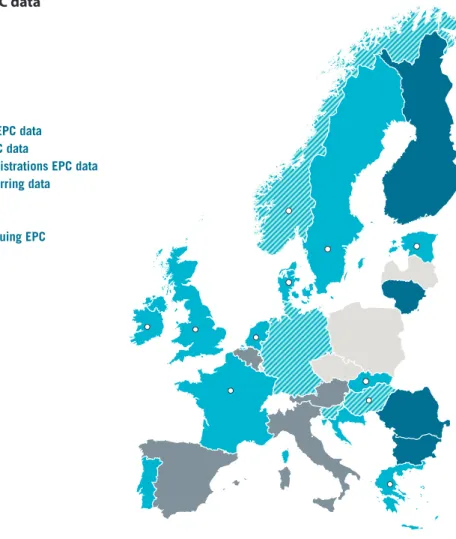
Public access to EPC data
Funding for databases is usually provided by the state, with the exception of the United Kingdom, where the registers in England, Wales and Northern Ireland, operated by Landmark, are funded through concession agreements. In some countries, the registry's budget is supported by EPC filing fees; for example, in Great Britain there is a fee of about 2 euros for residential and 12 euros for non-residential buildings, in Germany from 3 to 6 euros, in Lithuania 6 euros, in Ireland 25 euros for residential and 50 euros for non-residential buildings. of buildings, and the most expensive is Malta, where the cost of EPC registration is 75 euros.
Management of the EPC registers
In some countries (eg Bulgaria, Germany, Finland, Malta and Cyprus) there is no public access to the EPC database. Full access to the core of the database, meaning access to all raw data, is not guaranteed by any member state due to privacy issues58.
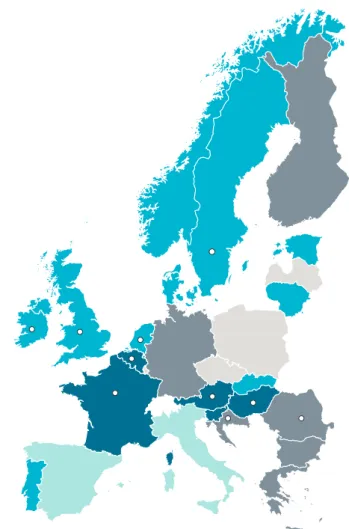
EPC label in public advertisements
Case study: Ireland 60
About 90% of the revenue generated is from market activity and the main sources of revenue are EPC expert registration and annual renewal fees. The funds raised support the maintenance and development of the system as well as for the quality assurance needs and other information gathering activities.
Case study: Portugal 61
Other improvements relate to the ability to load information via XML or the development of web services to communicate with databases or other entities. During this period, ADENE has compiled and published statistics based on the data stored in the central database, aiming to characterize various aspects related to the energy performance of the building stock.
Case study: Hungary 62
Until the implementation of the EPBD re-creation (December 2013), the number of issued EPCs exceeded 600,000 certificates and there were more than 100,000 in the current year (until July 2014). Only the database management body (LECHNER) has access to the raw data as well as some departments of the central government.
Case study: Sweden 63
By manually inserting the set of input calculation data of the building and the predefined results (set of output data). The way the database was set up had a positive impact on the quality of the EPC system.
Case study: Slovakia 64
The information in the database can be used for statistics that are also published online, for research purposes, for monitoring and evaluation of the energy consumption of the building stock, for government control, for policy evaluation and other activities where information about buildings and their energy performance forms a basis for assessments and decisions. For direct commercial purposes, it is not allowed to share information about personal code number, house designation, building designation, address, building energy performance, reference values and radon measurements.
Case Study: UK - England and Wales 65
In addition to those, for non-domestic buildings, the energy assessor will also mention heating services, lighting controls and information on the building envelope. Promoting and marketing energy efficiency improvements that can be made in accordance with a green deal plan;
5 THE FUTURE OF THE EPC SCHEME
CHALLENGES
Design and implementation of the EPC scheme
Compliance with national regulations
Compliance with the national regulation when the EPBD is implemented at member state level is one of the topics of discussion within the Joint Action (CA) EPBD68. The effective implementation of the energy performance certification scheme depends to a large extent on enforcement and monitoring mechanisms.
Public acceptance and market uptake of EPCs
To bridge this gap, the recast EPBD in 2010 introduced a mandatory requirement regarding penalties for non-compliance. The challenges identified in this regard in the Member States are lack of political support, lack of an effective system of sanctions for non-compliance, lack of resources to enforce the system's implementation, cultural issues and tradition of building regulations, expected costs of enforcement system, etc. .
EPC prices
EPC prices in most Member States are market driven and costs are also linked to the effort required to collect information about the building. The EPC price reflects the price of a certificate, but the value attributed to it is equally important.
OPPORTUNITIES
The value of EPCs is related to their utility, reliability, public acceptance and thus their influence on market decisions. Essentially, the criterion for successful market inclusion is that EPCs are deemed to have a value higher than the cost of acquisition.
EU Policy agenda 2030
The EPBD Concerted Action Report of 2011 [CA EPBD 2011b] concluded that EPC prices depend on characteristics directly linked to the energy performance calculation such as the applied methodology, the building type and complexity and the software used, and above all the qualified expert's work and asking price. Higher value is attributed to EPCs when they actually manage to bring benefits, such as cost-saving renovations with short payback periods, or an increase in the sale value of a property, thereby being effective as a market transformation tool that is evidently in the interest is. of the person acquiring it.
Transformation of Europe’s property market
Interest in the potential use of the EPC database for commercial purposes is growing. An interesting private initiative utilizing the EPC database is Meer met Minder (More with Less)76.
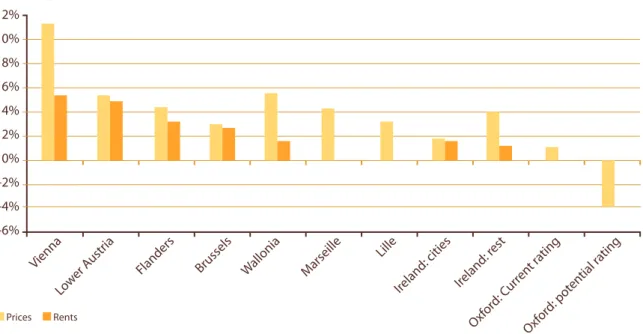
6 CONCLUSIONS
AND RECOMMENDATIONS
Lack of enforcement of the penalty system can significantly undermine the quality, credibility and utility of EPC schemes. Quality control in the EPC database The EPC issues after uploading the data to the database Presence of the EPC database.
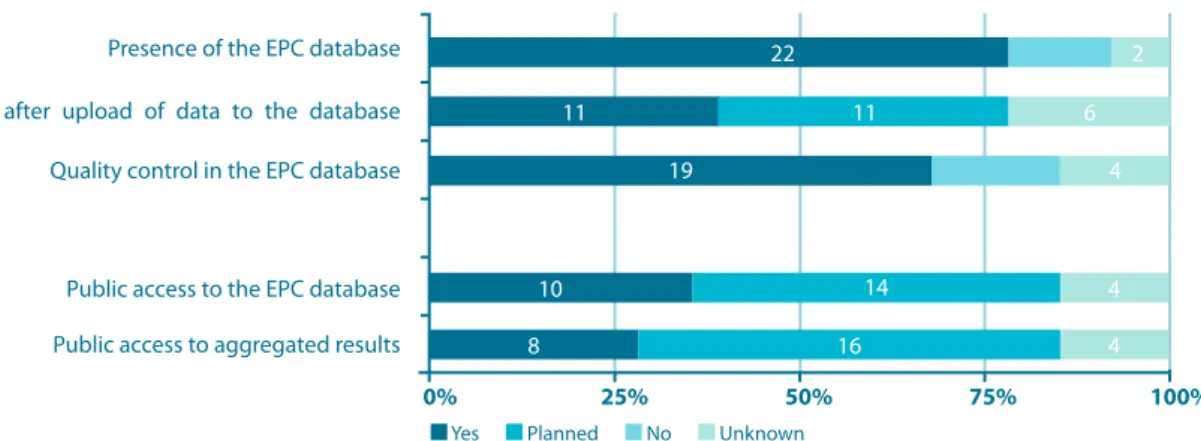
Based on the analysis of the current status of implementation of the Energy Performance Certification across Europe, a set of policy
- Need to consistently improve enforcement of the EPC schemes in Member States and strengthen the monitoring of EPC scheme compliance both at Member State and
- Need to strengthen the role of EPCs in the context of national legislation, especially for renovation policies and programmes
- There is a need to introduce further quality assurance measures, especially during the early stage of the certification process. Member States should ensure that inter alia
- Need for guidance in development of the centralised EPCs databases and digitalisation of the EPC process
- There is a need to promote the effective use of the EPC data
- Finally, there is a need for independent evaluation of the effectiveness of the EPC scheme
The qualification of certification bodies is among the most influential factors on the quality of EPC. A comprehensive analysis of the effectiveness of EPC in the market across Europe is lacking.
BIBLIOGRAPHY
2011), The Impact of Energy Certificates on the Rent and Capital Value of Commercial Property: Some Preliminary Evidence from the United Kingdom. UK (2010) Making better use of energy performance cards and data - a summary of responses Vreeker R., Deakin M., Curwe S. editors) (2009), Sustainable Urban Development Volume 3: An Assessment Tool, Routledge Publications.
ANNEXES
Minimum requirements for qualified and / or accredited experts (physical person)
Quality control systems across Europe

